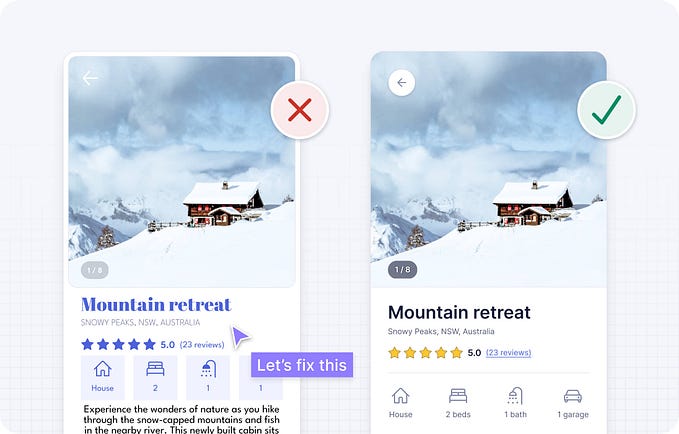
Mobile App UX Design: Prompting For App Review
by Nick Babich
“Please rate our app!” pop-up dialog has become a common thing in modern mobile apps. We prompted to leave a review almost every day. Most users find such requests annoying:

John Gruber, of Daring Fireball, criticized the modern approach for request for reviews:
I’ve long considered a public campaign against this particular practice, wherein I’d encourage Daring Fireball readers, whenever they encounter these “Please rate this app” prompts, to go ahead and take the time to do it — but to rate the app with just one star and to leave a review along the lines of, “One star for annoying me with a prompt to review the app.”
Forcing users to rate the app is absolutely unacceptable these days. However, we still need to encourage users to rate your app to let our business grow. In this article we’ll try to find an answer to the question: “How can I prompt my users for rating and review without driving them nuts?”
Why Ratings And Reviews Matter
App ratings can positively or negatively affect important aspects of how people discover our apps. Reviews can literally make or break the app:
- For Developer. Getting feedback on your app is important, especially when it tells you that your app is doing poorly.
- For Marketers. Reviews affect how visible the app will be in AppStore /GooglePlay search results and how likely users will find the app.
- For Users. Both Apple AppStore and Google Play put ratings right alongside an app’s icon and title, giving users a quick way to judge the app’s quality. It’s not secret that user decision-making based on app ratings (potential customers are more likely to download an app that’s averaging 4 stars or above).
It makes perfect sense for us as product creators to do everything we can to maximize the positive marketing of our apps. With this in mind, lets take a look at some of the better ways we can ask customers for reviews.
Ratings Prompts: Don’ts and Do’s
App reviews just don’t happen by themselves. Something should be done to encourage users to leave ratings and reviews.
Don’t: Interrupt Customers In The Middle of Tasks Or at App Launch
The easiest way to get an app review from users is to ask them to do it within your app. Unfortunately, most apps find inappropriate time for triggering the request for feedback — they’ll prompt the request right during the launch. Modal pop-ups interrupt a user’s workflow and demand that users either leave a review now or be reminded later. If you have used a mobile device before, you have almost certainly seen a dialog that looks something like this:

Asking such question at launch is hands down one of the worst possible times to ask. It’s no surprise that showing a ratings prompt on launch is 50% more likely to result in the app being closed than if it’s shown at any other point in the app. This practice is offensive and it’s really no wonder users and critics have condemned the use of “rate app” dialog.
Takeaways:
- Avoid interrupting users by asking them to rate your app when they’ve only recently downloaded it or only used it a few times.
- Don’t ask for review during the launch and try not to bother users when they’re in the middle of something.
Don’t: Prompt For Review With Each New Version
You should trigger “Rate the app” dialog only once. Ensure that the user never sees the dialog again if they select the “No, Thanks” option.
Do: Find a Proper Moment To Ask For Review
You should find a moment in your app that’s the least intrusive. If you prompt the customer at some point while the app is running you’re always going to disrupt their workflow, but you can ease this by trying to find a moment that’s the least disruptive. Clear is a good example of this in action.

To quote Dan Counsell: “Clear for iOS shows the “Rate app” dialog after a few conditions have been met, firstly the user must have been using the app for a few weeks, secondly Clear will only ask after the user has cleared the remaining tasks from a list. This is a great moment in the app; users are feeling good for having just cleared their todo list and in most cases are just about to exit the app.”
Takeaways:
- You could trigger the rating request after a specific number of tasks/goals have been completed. Choose the perfect moment (especially after a positive interaction).
- Prompting for a review when users are feeling good about the app makes it beneficial for both the app developer and the user: user will be more likely to leave a positive rating and provide more informed feedback.
Do: Integrated Rating Requests
The trouble with the pop-up approach is that the app is interrupting the user’s natural workflow. A method that’s more integral into the experience is a better way to prompt for review:
You can add a ‘Rate the app’ as an option within the app. This negate the need to bother the user with a feedback request, so from that perspective it’s a great option.

Do: Ask Outside the App
You can gently ask for reviews in the update notes. It’s more polite than prompting in the app, and it definitely increases the number of reviews when an update comes out. Castro is a good example of this in action.

Conclusion
There’s nothing wrong in asking for a review, but remember that you want to give your users a great experience first. The more people will be satisfied with your app, the more likely they will want to leave a positive feedback and tell others to try your product.
Thank you!
Follow UX Planet: Twitter | Facebook
Originally published at babich.biz










